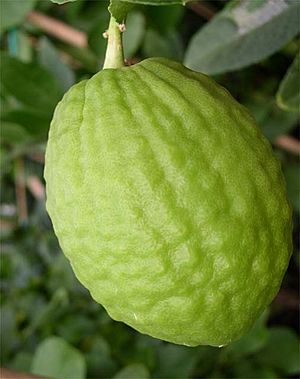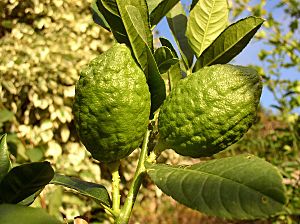Corsican citron facts for kids
The Corsican citron is a special type of citron fruit. It's known for having a pulp that isn't sour. People in Corsica, a French island, call it alimea. In French, it's called cedrat.
This fruit gets its name from Corsica, where it has been grown for a very long time. It's believed to be one of the first citrus fruits to arrive on the island.
History and Uses of the Corsican Citron
For many years, the Corsican citron was very important for making Succade, which is candied fruit peel. The fruit was sent to Genoa, Italy, and then to large centers in Livorno. There, the pulp was removed, and the peel was prepared. This is why it was sometimes called the Citron of Commerce.
Corsica used to be the biggest producer of citron in the world, growing about 45,000 tons each year! A historian named Laurence Pinelli explained how important it was:
Citron brought a lot of wealth to Corsica. It changed the look of the land, added so much to our food, and really helped the island's economy.
Citron for Special Traditions
Sometimes, merchants from Genoa would also send Corsican citrons to Jewish communities. This was for a special religious ritual called Etrog. They would do this if there weren't enough of the Diamante citron available. However, this practice stopped because the Greek citron was thought to be more beautiful.
Today, Corsican citrons are often cooked with sugar to make a delicious jam.
What Does a Corsican Citron Look Like?
The Corsican citron tree grows slowly and usually reaches about 3 to 4 meters (10 to 13 feet) tall. It has an open, spreading shape and some strong thorns.
The tree's flowers are very fragrant and bloom from March to September. These blossoms are great for honey bees, helping them make good honey. The flowers, buds, and new leaves do not have a purple tint.
The fruit itself is quite large. It's shaped like an oval, sometimes a bit wider at the top. When ripe, it turns a bright lemon-yellow color. The peel is very thick and fleshy. It tastes sweet, but can have a slightly bitter aftertaste. The surface of the fruit is usually rough, bumpy, and sometimes has ribs.
The inside of the fruit is firm and crisp, but it doesn't have much juice. It tastes sweet and isn't sour at all. The seeds are yellowish-white. These giant citrons can grow up to 25 centimeters (10 inches) long and weigh as much as 4 kilograms (nearly 9 pounds)!



